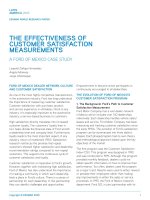Tài liệu The international community and the “NTP for coping with CC” pdf
Bạn đang xem bản rút gọn của tài liệu. Xem và tải ngay bản đầy đủ của tài liệu tại đây (32.59 KB, 11 trang )
The international community and
the “NTP for coping with CC”
Koos Neefjes, UNDP
ISGE Policy Dialogue
Hanoi, 23 January 2008
2
This presentation:
1. Current international support to Viet Nam
on CC (UNDP and others)
2. What is needed, now and later?
3. International support, cooperation and
coordination
3
1. Current international support to
Viet Nam on CC
• Support to the mitigation of effects of CC and
adaptation to new realities
• Support to mitigation of GHG emissions
• Support to developing carbon markets
• Support to research, data collection and analysis
• Support to development of national policies,
strategies, plans
• Support to national-international coordination,
policy dialogue, ODA channeling
4
2. What is needed, now and later? (a)
VN and other experience: a full, comprehensive NTP cannot be
developed in just 6-7 months, but a general CC policy and an outline
of action plans can. So ……(I, II, III ….)
I. An overall, national policy or strategy, with two CC-related policy
aims, on reducing vulnerabilities for CC effects and on mitigation of
GHG emissions.
E.g
.:
• Set the target year by which Viet Nam will have started significant
reduction of CC vulnerabilities of critical sectors and localities to the
main effects of CC (e.g. sea level rise, increased drought in certain
localities)
• Set the target year by which Viet Nam will start reducing its carbon
footprint (the HDR suggests that on average the developing
countries should start that after 2020)
5
2. What is needed, now and later? (b)
• Formulate a strategic framework to achieve both policy
aims
• Stress the importance of and potential for synergies
between economic development, vulnerability reduction
and GHG reduction in the medium and long term,
instead of “trade offs”. This will require technology
transfers, R&D, capacity building, finance …
• Use this policy (a) to mainstream CC-related vulnerability
reduction and emissions mitigation in all sorts of national
strategies and national action plans; (b) to mobilize
national and international financial resources to address
the causes and effects of CC; and (c) to play a central
role in post-Kyoto international negotiations.
6
2. What is needed, now and later? (c)
II. An action plan or NTP to address CC effects (CC Adaptation)
Immediate action CCA (Phase 1; first 2-3 years), e.g
.
• Improve early warning systems
• Develop sea level rise and drought scenarios (impact on water
resources)
• Deepen the understanding of vulnerabilities and CCA potentials
• Provincial CC vulnerability assessments
• In-depth consultation with key stakeholders and the wider public
• Refine the CCA strategy
• Adopt CC impact scenarios as the basis for public and private
investments
• Mainstream reduction of CC-related vulnerabilities in (national, local,
sectoral) strategies and plans for 2011 and beyond; in public
investment decisions; and policy instruments such as SEA
• Articulate VN policies, strategies and plans on vulnerability reduction in
the context of post-Kyoto negotiations
7
2. What is needed, now and later? (d)
Longer term action CCA (Phase 2) to focus on:
• Implementation of specific projects (sectoral, and
integrated in localities) to reduce vulnerabilities, with
national and international resources, public and private
• Stress capacity building at all levels, and focus on the
most vulnerable social groups, localities, and the most
sensitive economic sectors
8
2. What is needed, now and later? (e)
III. A detailed strategy, action plan or NTP to address GHG mitigation
Immediate actions GHG mitigation (Phase 1; first 2-3 years), e.g.:
• Strengthen / speed up activities related to GHG mitigation under the
National Programme on Energy Efficiency
• Valuation of forest coverage in terms of carbon sequestration and
articulate trade potential
• Build capacities to regulate, manage and stimulate the carbon market
• Build research capacities and initiate research on emissions, potential
efficiency gains
• Refine GHG emissions targets (e.g. based on data produced for the
Second Communication)
• Articulation of VN policies, strategies and plans on GHG mitigation in
the context of post-Kyoto negotiations
• Mainstream reduction of GHG emissions/consumption as well as
carbon sequestration in sector strategies and action plans, notably
Trade & Industry, Transport, Construction, Agriculture & Rural
Development; and in local action plans for 2011 and beyond.
9
2. What is needed, now and later? (f)
Longer term actions GHG mitigation (Phase 2)
• Achieve behaviour change re carbon use by the public sector,
consumers and industry, from public awareness raising and
regulation
• Stress capacity building at all levels, and focus on technology
adoption and research & development (R&D), in industrial and
agricultural production, transportation, electricity generation (public
& business sectors)
• Emissions reduction later is important for investment decisions now,
such as those related to electricity generation (focus on renewable
energy) (public sector), and cleaner production (business sector)
• There is a huge need for incentives for and co-funding from the
business sector to increase energy efficiencies, adoption and
development of new technologies, etc. : develop PPPs?
10
3. International support,
cooperation and coordination (a)
National coordination and CC policy development
• Excellent decision to involve all relevant ministries / sectors. Should
include the Ministry of Finance and link to the inter-ministerial
budgetary adaptation process.
• NCSD (set up in the context of VN Agenda 21), and development of
local Agenda 21
International-national coordination
• ISGE, also NDM-P, FSSP, … : general policy dialogue, information
exchange, coordination
• PRSC process: multi-sector; high interest of donors; strategy / policy
focus. Basis for general budget support and also sector-wide ODA
• Informal: project exchanges
11
3. International support,
cooperation and coordination (b)
Key actions that the international community can support with funds and experts:
• Research (vulnerabilities, emissions, technology development)
• Capacity building (e.g. to guide and stimulate carbon markets)
• Investments (e.g. infrastructure to mitigate effects, and energy generation)
Immediate support to formulation of the NTP (policy, strategy….): by June 2008!
• Key role for ISGE to bring international agencies and some international
experts into the formulation process
• Plan, fund and implement national consultations (overall policy, immediate
actions)
• Plan, fund and implement 2-3 international consultations (such as today)
• Fund secretarial, logistics, translation support to the drafting team (ISGE?)
• Some international experts to work “hands on” with the drafting team (UNDP,
Denmark, …?)
• Compilation of international experience to inform Vietnamese policy / NTP(s)
(other countries’ policies, action plans)









